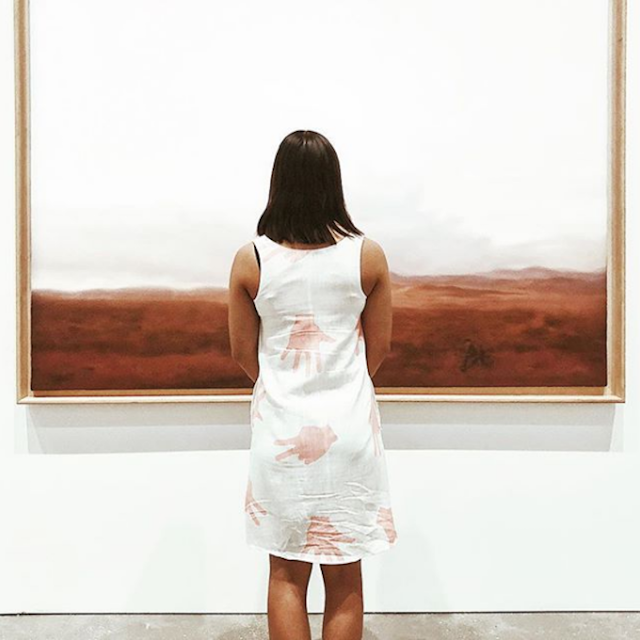With 800 million users and growing, it was perhaps inevitable that Instagram would shake up the art world. The social photo platform has been accused by the media of fanning a narcissistic selfie culture. But in galleries, research is showing that the negative aspects are far outweighed by the positive. Instagram is changing the way we experience and share our visits to exhibitions, and how we perceive art.
In fact, arts institutions are now actively courting Instagram users. The Museum of Ice Cream in the US is considered one of the most Instagrammed exhibitions, with over 125,000 hashtagged posts. The show included such Insta-friendly displays as giant cherries, suspended bananas, and a rainbow sprinkle pool, inviting the visitor into a colourful space of neatly guided photo opportunities.
Closer to home, the current Triennial at the National Gallery of Victoria features several large, Insta-friendly installations. Visitors are invited to lie on Alexandra Kehayoglou’s carpet work, Santa Cruz River (which depicts a river in Argentina that is at the centre of a contentious damming proposal), and take their photo in a mirror on the ceiling.
Artist Yayoi Kusama, also at the Triennial, uses light, space, colour and patterns and attracts a strong Instagram fanbase to her exhibitions. Kusama’s obliteration room, currently being exhibited in Queensland, is another popular, Instagrammed experience, which invites visitors to stick colourful dots all over a white room. A similar work at the NGV covers the interior of a house with flowers.
Perils and possibilities
Increased visitor photography at galleries and museums has proved controversial at times. Recently a visitor to Los Angeles pop-up art gallery The 14th Factory destroyed $200,000 worth of crown sculptures. The sculptures rested on top of a series of plinths, and while attempting a selfie the visitor fell, knocking the plinths down in a domino style chain reaction.
In another instance visitors damaged an 800-year-old coffin at the Prittlewell Priory Museum in the UK. The visitors had lifted a child over a protective barrier into the coffin in pursuit of the perfect photo. Their actions caused the ancient artefact to be knocked off its stand resulting in a large piece of the coffin breaking off.
Many exhibitions still place restrictions on photography, and most galleries still prohibit selfie sticks. Reasons often cited for these restrictions include copyright considerations, concerns over the visitor experience, and potential for damage to works caused by manoeuvring selfie sticks and flash lighting (although it is debatable whether flashes do damage art).
Banning photography on the basis that it interferes with the visitor’s experience could be seen as cultural elitism; expressing a view that art can only be appreciated in an orthodox manner. It also ignores the potential of Instagram to bring a new dimension to artists, curators, exhibition designers and visitors.
Recent research at Queensland’s Gallery of Modern Art Gerhard Richter exhibition showed that visitors use Instagram as part of their aesthetic experience. A number of participants posted Richter’s art works on Instagram creatively immersing themselves in the image, wearing clothes matching the art, and copying Richter’s signature blurred style.
Another study at the Museum of Applied Arts and Sciences’ Recollect: Shoes exhibition in Sydney found that audiences used Instagram primarily to engage with exhibition content; not by taking selfies. Visitors mostly photographed the intricate details of the shoes’ design.
This finding was echoed in a larger study that focused on Sydney’s Museum of Contemporary Art. Far from the narcissistic selfie-obsessive behaviour that much media coverage insists is occurring, Instagram offers visitors authority and agency in sharing their experience.
This connects audiences with museum content in a way that they can control and is meaningful to them. New research shows how this activity is also tied to place - the museum, and the city beyond it.
Using Instagram in public spaces like museums and galleries is complex. It’s tied to broader research that shows how social media use in public spaces is challenging a range of social norms.
As researchers working in this emerging area, we see much value in curators and exhibition designers making use of Instagram to inform how they plan exhibitions. It could help build new audiences and strengthen connections with existing visitors. While removing all visitor photography restrictions is not possible, it is our view that visitor expectations and experiences have now changed. The future of cultural institutions needs to include Instagram.

